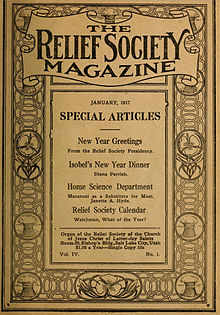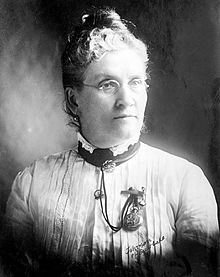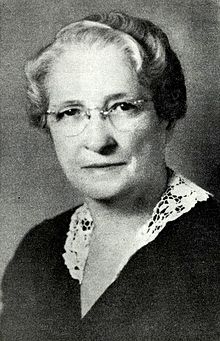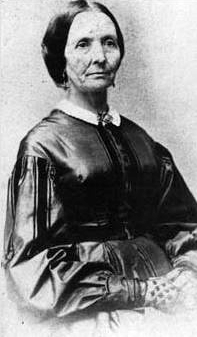
Eliza Roxcy Snow was one of the most celebrated Latter Day Saint women of the nineteenth century. A renowned poet, she chronicled history, celebrated nature and relationships, and expounded scripture and doctrine. Snow was married to Joseph Smith as a plural wife and was openly a plural wife of Brigham Young after Smith's death. Snow was the second general president of the Relief Society of the Church of Jesus Christ of Latter-day Saints, which she reestablished in Utah Territory in 1866. She was also the sister of Lorenzo Snow, the church's fifth president.

The Relief Society is a philanthropic and educational women's organization of the Church of Jesus Christ of Latter-day Saints. It was founded in 1842 in Nauvoo, Illinois, United States, and has more than 7 million members in over 188 countries and territories. The Relief Society is often referred to by the church and others as "one of the oldest and largest women's organizations in the world."
The status of women in Mormonism has been a source of public debate since before the death of Joseph Smith in 1844. Various denominations within the Latter Day Saint movement have taken different paths on the subject of women and their role in the church and in society. Views range from the full equal status and ordination of women to the priesthood, as practiced by the Community of Christ, to a patriarchal system practiced by the Church of Jesus Christ of Latter-day Saints, to the ultra-patriarchal plural marriage system practiced by the Fundamentalist Church of Jesus Christ of Latter-Day Saints and other Mormon fundamentalist groups.

The Woman's Exponent was a semi-official publication of the Church of Jesus Christ of Latter-day Saints that began in 1872. It published articles advocating for women's suffrage and plural marriage, in addition to poetry and other writings. Lula Greene Richards and Emmeline B. Wells were its editors until 1914, when the Exponent was dissolved. It was "the first long-lived feminist periodical in the western United States." While it had no direct successor, the Relief Society did launch its own magazine, the Relief Society Magazine, in 1915.
In the Church of Jesus Christ of Latter-day Saints, the Priesthood Correlation Program began in 1908 as a program to reform the instruction manuals and curriculum of the different organizations of the church. Its scope quickly widened and Correlation came to have large effects on almost every aspect of the church including doctrines, organizations, finances, and ordinances. A significant consequence was to centralize decision making power in the priesthood, particularly the Quorum of the 12 Apostles. More recently, the function of the correlation department has shifted to planning and approving church publications and curriculum and keeping unorthodox information, doctrines and other undesired concepts from being introduced or revived.

Emmeline Blanche Woodward Harris Whitney Wells was an American journalist, editor, poet, women's rights advocate, and diarist. She served as the fifth Relief Society General President of the Church of Jesus Christ of Latter-day Saints from 1910 until her death. She represented the state of Utah at both the National and American Women's Suffrage conventions and was president of the Utah Woman's Suffrage Association. She was the editor of the Woman's Exponent for 37 years. She was a plural wife to Newel K. Whitney, then Daniel H. Wells.
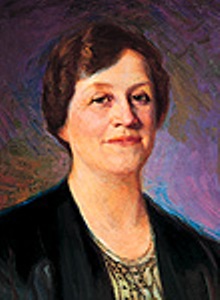
Sarah Louisa Yates Robison was the seventh Relief Society General President of the Church of Jesus Christ of Latter-day Saints from 1928 to 1939.

Ruth Fox was a 19th-century English-born American women's rights activist in the Territory of Utah. Fox was a poet, hymn writer, and a leader of youth in the Church of Jesus Christ of Latter-day Saints.

Susa Gates was an American writer, periodical editor, president of the Daughters of Utah Pioneers, and women's rights advocate. She was a daughter of LDS Church president Brigham Young. Throughout her life, Gates wrote many short stories, novels, poems, and other literary works. According to R. Paul Cracroft's thesis, Gates wrote more than other Mormon writers. Gates was also actively involved in the Church of Jesus Christ of Latter-day Saints where, among other things, she wrote the lesson manuals, was a member of the Relief Society general board, lead genealogical efforts, and served as a missionary.

Louisa Lula Greene Richards was a poet and was the first female periodical editor in Utah Territory. Richards's work was published under a variety of names, including Louisa L. Greene, Louise L. Green, Lula Green, and Lula G. Richards. She was a member of the Church of Jesus Christ of Latter-day Saints.

Richard Ballantyne was the founder of the Sunday School of the Church of Jesus Christ of Latter-day Saints, having begun the program in December 1849. He was also a Mormon pioneer and missionary.
Janne Mattson Sjödahl was a Swedish convert to the Church of Jesus Christ of Latter-day Saints and was the author of influential commentaries on LDS Church scriptures. Sjödahl was among the first commentators to advance a "limited geography model" for the theorized geography of the Book of Mormon.

Alexander Neibaur was the first dentist to practice in Utah and the first Jew to join the Latter Day Saint movement. He was educated for the profession at the University of Berlin and was a skilled dentist before the establishment of dental schools in America. He was fluent in 7 languages and as many dialects.

Jane Snyder Richards was a counselor to Zina D. H. Young in the general presidency of the Relief Society of the Church of Jesus Christ of Latter-day Saints from 1888 to 1901.
Mormon feminism is a feminist religious social movement concerned with the role of women within Mormonism. Mormon feminists commonly advocate for a more significant recognition of Heavenly Mother, the ordination of women, gender equality, and social justice grounded in Mormon theology and history. Mormon feminism advocates for more representation and presence of women as well as more leadership roles for women within the hierarchical structure of the church. It also promotes fostering healthy cultural attitudes concerning women and girls.

The following outline is provided as an overview of and a topical guide to the Church of Jesus Christ of Latter-day Saints.

Merry May Talmage was a member of the Church of Jesus Christ of Latter-day Saints and was the wife of James E. Talmage, a member of the Quorum of the Twelve Apostles. She oversaw the Relief Society in Europe from 1924 to 1927 when her husband was the president of the European Mission of the church.
Since the beginning of political activity in Utah, Women were highly involved in their local political system. This is evident in the very fact that the Utah Constitution granted women the right to vote—20 years before the 19th Amendment was passed nationally. Despite high levels of female participation in politics and government, the issue of women's suffrage saw both support by Utah women and opposition by many other Utah women.

